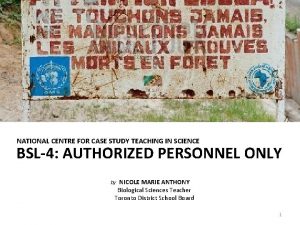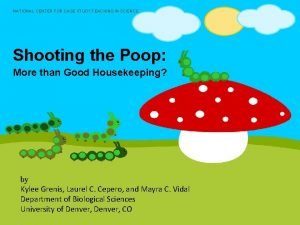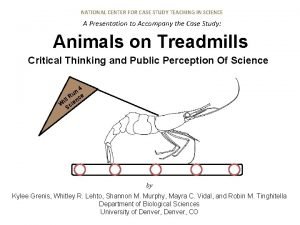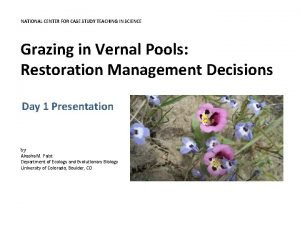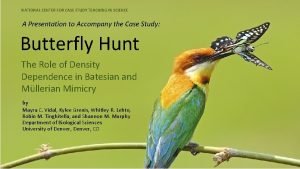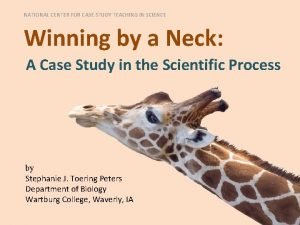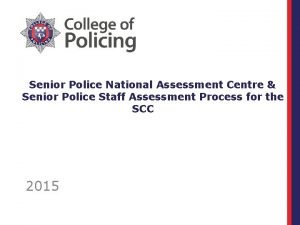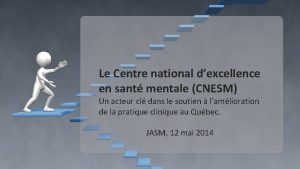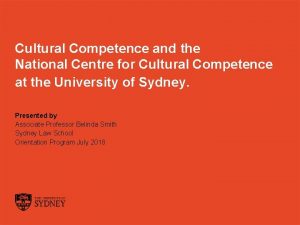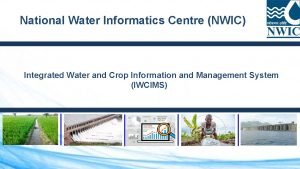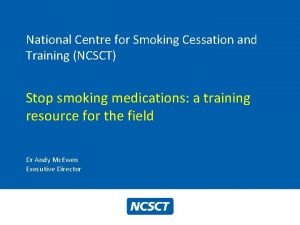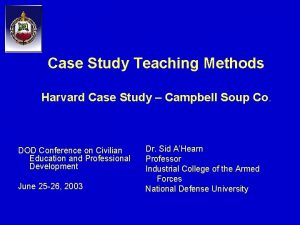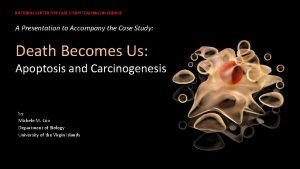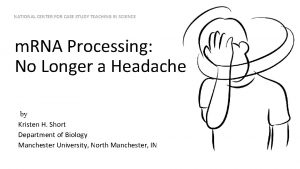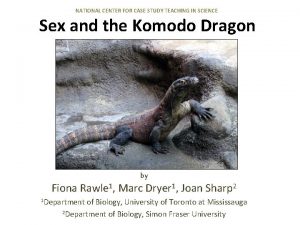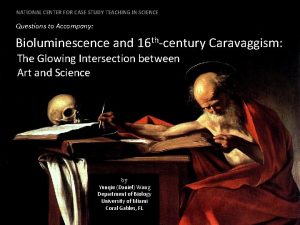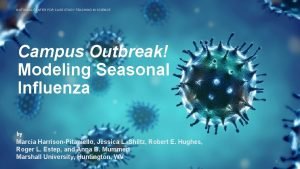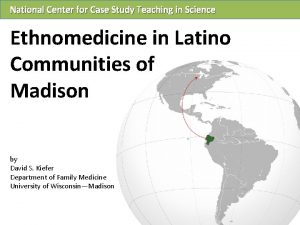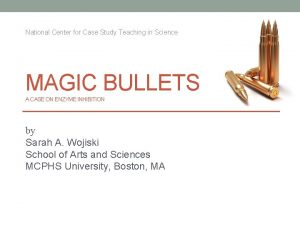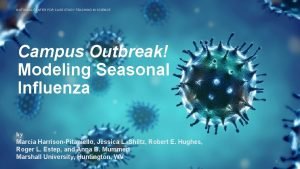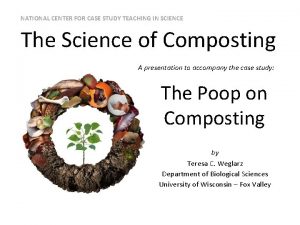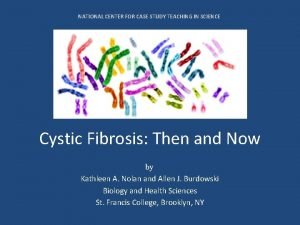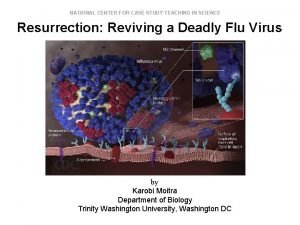NATIONAL CENTRE FOR CASE STUDY TEACHING IN SCIENCE























- Slides: 23

NATIONAL CENTRE FOR CASE STUDY TEACHING IN SCIENCE BSL-4: AUTHORIZED PERSONNEL ONLY NICOLE MARIE ANTHONY Biological Sciences Teacher Toronto District School Board by 1

Group Brainstorming • Based on the information presented in the case so far, address the following questions in your groups: 1. What problem is presented? 2. What do we know about the problem? 3. What is still unknown about the problem? 2

CQ#1: What does “BSL-4” stand for? A. B. C. D. Bachelor of Science in Law (4 -year degree) Biological Space Laboratories (Unit 4) Biosafety Level (Category 4) Breed-specific legislation (Section 4) 3

CQ#2: BSL-4 category agents are: A. not associated with disease in healthy humans. B. associated with human disease that is rarely serious and for which preventative or therapeutic interventions are often available. C. associated with serious or lethal disease for which preventative or therapeutic interventions may be available. D. associated with serious or lethal human disease for which preventative or therapeutic interventions are not usually available. 4

CQ#3: Which type of pathological agent(s) is/are classified under the BSL-4 category? A. B. C. D. E. Viral agents Fungal agents Bacterial agents Parasitic agents All of the above 5

CQ#4: Based on the information revealed in the story so far, what type of pathogenic agent do you think Claire and Dr. Preston have contracted? A. B. C. D. E. Viral agent Fungal agent Bacterial agent Parasitic agent Difficult to determine with the given information 6

CQ#5: Based on the information revealed in the story so far, do you think Claire and Dr. Preston will survive? A. Yes B. No C. Difficult to determine with the given information 7

Disease Detective Rewind back to December of 2013; the time of the onset of the outbreak in West Africa. Imagine that you are a medical health official and that a cluster of illnesses have appeared at your clinic, all of which present with similar symptoms. Many of the cases have been fatal and you need to make a diagnosis immediately in order to stop the spread and to properly treat the sick patients. Consider these questions and discuss them within your group. 1. What steps would you take to make a diagnosis? 2. What are some ways to determine which pathogen is responsible for the outbreak? 3. What measures would you employ to prevent further spread 8 of the disease?

CQ#6: Do all three of the pathogens that you selected appear in the list below? Lassa Fever Ebola Hemorrhagic Fever Malaria Marburg Hemorrhagic Fever Crimean-Congo Hemorrhagic Fever Typhoid Fever A. Yes B. No 9

CQ#7: Which grouping consists of the three best matched pathogens to this case? A. LF, Malaria, TF B. MHF, Malaria, TF C. CCHF, MHF, EHF D. TF, EHF, MHF E. EHF, Malaria, MHF F. LF, TF, CCHF G. TF, MHF, CCHF 10

Recognizing the Biosafety Levels After completing the Quick Learn Lesson, you should be able to correctly identify BSLs. http: //www. cdc. gov/training/quicklearns/biosafetyce/biosafety. CE. html • Select the biosafety level described by the conditions in the following examples. 11

CQ#8: A microbiology graduate student is working on a project under the following conditions: • Work is conducted on a standard laboratory table or bench. • A nonpathogenic laboratory strain of E. coli is being used. • Minimal PPE, such as a lab coat, gloves, and eye protection might be worn but are not necessary. A. BSL - 1 B. BSL - 2 C. BSL - 3 D. BSL - 4 12

CQ#9: Select the biosafety level shown in the photo. A. BSL - 1 B. BSL - 2 C. BSL - 3 D. BSL - 4 13

CQ#10: Select the biosafety level described by the conditions of the following example. Levels are listed below. • Work is conducted on a standard laboratory bench in a contained area. • PPE, including a lab coat, gloves, and eye protection are being used to reduce accidental infection. A. BSL - 1 B. BSL - 2 C. BSL - 3 D. BSL - 4 14

CQ#11: Select the biosafety level shown in the photo. A. BSL - 1 B. BSL - 2 C. BSL - 3 D. BSL - 4 15

CQ#12: Which ELISA format is the most suitable for this case? (Lab Activity A, Question 1) A. B. C. D. Direct Indirect Sandwich Competition/Inhibition 16

CQ#13: Based on the test results from patient zero’s sample, which virus caused the outbreak? (Lab Activity A, Question 2) A. B. C. D. Ebola hemorrhagic fever virus Marburg hemorrhagic fever virus Crimean-Congo hemorrhagic fever virus Test results are inconclusive 17

A sign warns visitors that area is a Ebola infected. MAKOUA CONGO AFRICA - SEPTEMBER 27 2013 18

CQ#14: Based on the phylogenetic tree, which strain is the virus isolated from patient zero’s sample most closely and least closely related to? (Lab Activity B, Question 1) A. B. C. D. E. F. Zaire; Sudan (respectively) Zaire; Bundilbugyo (respectively) Bundilbugyo; Zaire (respectively) Sudan; Reston (respectively) Zaire; Cote d’Ivoire (respectively) Results from the tree are inconclusive 19

Supplemental Material 20

1. Average Fatality Rate by Ebola Virus Strain 2. How Ebola is Transmitted 3. Fruit Bat Territory Overlay of Outbreaks http: //www. huffingtonpost. com/2014/07/30/ebola-map_n_5632280. html 4. Ebola Virus Structure and Genome Organization http: //journal. frontiersin. org/Journal/10. 3389/fmicb. 2012. 00034/full 5. Filovirus Replication in a Cell http: //journal. frontiersin. org/Journal/10. 3389/fmicb. 2012. 00034/full 6. Ebola Virus Phylogeny, including Guinea Strains http: //www. nejm. org/doi/pdf/10. 1056/NEJMoa 1404505 7. Zaire Ebola Virus Phylogeny http: //currents. plos. org/outbreaks/article/phylogenetic-analysis-ofguinea-2014 -ebov-ebolavirus-outbreak-2/ 8. Haemorrhagic Manifestations in Monkeys http: //www. ncbi. nlm. nih. gov/pubmed/21084112 21

Yambuku, 1976 - Ebola Virus Discovery Team 22

Image Credits Slide 1 & 18 Description: Attention Ebola. Makoua Congo Africa – September 27 2013: A sign warms visitors that area is Ebola infected. Source: ©SURZ- Stock Photo ID: 59648213 http: //www. bigstockphoto. com/image-59648213/stock-photo-attention-ebola Clearance: License to be purchased by the author of this case pending NCCSTS approval. Slides 13 and 15 Description: Biosafety equipment and practices. Source: CDC, Recognizing the Biosafety Levels http: //www. cdc. gov/training/quicklearns/biosafetyce/biosafety. CE. html Clearance: Images are in the public domain. Slide 22 Description: Photo of Peter Piot, circa 1976. Source: American Association for the Advancement of Science. Accessed from: http: //news. sciencemag. org/africa/2014/08/part-one-virologists-tale-africas-first -encounter-ebola 23 Clearance: Permission for use has not been obtained.
 National center for case study teaching in science
National center for case study teaching in science National center for case study teaching in science
National center for case study teaching in science National center for case study teaching in science
National center for case study teaching in science National center for case study teaching in science answers
National center for case study teaching in science answers National center for case study teaching in science
National center for case study teaching in science National center for case study teaching in science
National center for case study teaching in science National center for case study teaching in science
National center for case study teaching in science Best worst and average case
Best worst and average case Crm failure case study
Crm failure case study What is your favourite lesson
What is your favourite lesson Difference between centre of mass and centre of gravity
Difference between centre of mass and centre of gravity Centroid and centre of gravity
Centroid and centre of gravity What is scaled down teaching
What is scaled down teaching Orce assessment
Orce assessment Nslsc number
Nslsc number Centre national d'excellence en santé mentale
Centre national d'excellence en santé mentale National centre for cultural competence
National centre for cultural competence National operations centre
National operations centre National minor illness centre
National minor illness centre National innovation centre for data
National innovation centre for data Hartree national centre for digital innovation
Hartree national centre for digital innovation Iwcims
Iwcims National centre for smoking cessation and training
National centre for smoking cessation and training Oman national centre for statistics and information
Oman national centre for statistics and information
